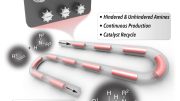
Indoor air is an underestimated yet potentially significant source of PFAS exposure, especially for children.
The air we breathe in our homes, schools, and workplaces can be polluted with harmful PFAS chemicals, according to a study published today (August 31, 2021) in Environmental Science & Technology Letters. A new measurement technique developed by the research team detected PFAS chemicals in the air of kindergarten classrooms, university offices and laboratories, and a home—some with levels as high as those measured at an outdoor clothing company and carpet stores selling PFAS-treated products. The results suggest indoor air is an underestimated and potentially important source of exposure to PFAS, particularly for children.
“Food and water are known to be major sources of PFAS exposure,” said Rainer Lohmann, senior author of the study and professor of oceanography at the University of Rhode Island. “Our study shows that indoor air, including dust, is another source of exposure to potentially harmful forever chemicals. In fact, for children in homes or schools with old PFAS-treated carpets, inhalation maybe even more important than dust as an exposure pathway to volatile PFAS that eventually could biotransform to more persistent and harmful PFAS.”
Well-studied PFAS have been associated with a wide range of serious health harms, from cancer to infertility to immune system problems. All PFAS are either extremely persistent in the environment or break down into extremely persistent PFAS.
By affixing polyethylene sheet samplers to ceilings, the scientists measured volatile PFAS chemicals in the air of nine carpeted kindergarten classrooms, one home, and the storage room of an outdoor clothing store in California; as well as two laboratories, five offices, one classroom, one storage room, and one elevator at the University of Rhode Island; and two carpet stores, also in Rhode Island. PFAS were detected in the air of nearly every location.
Several kindergarten classrooms and rooms at the university had higher indoor air concentrations of PFAS than the storage room of the outdoor clothing store, which was full of jackets and gear treated with PFAS. The highest concentrations were found in the two carpet stores. “PFAS were formerly used as stain and water repellents in most carpets,” according to the paper’s lead author Maya Morales-McDevitt. “Fortunately, major retailers including The Home Depot and Lowe’s now only sell PFAS-free carpets. We believe that slowly smaller retailers will do so as well.”
While families, schools, and workplaces can reduce indoor air levels of PFAS by replacing carpets, there are still many other products that can emit volatile PFAS into indoor air, including clothing, shoes, building products, and furnishings.
“As long as they continue to be used in products, we’ll all be eating, drinking, and breathing PFAS,” said Tom Bruton, a co-author and senior scientist at the Green Science Policy Institute. “We need to turn off the tap and stop all unnecessary uses of PFAS as soon as possible.”
Reference: “The Air That We Breathe: Neutral and Volatile PFAS in Indoor Air” by Maya E. Morales-McDevitt, Jitka Becanova, Arlene Blum, Thomas A. Bruton, Simon Vojta, Melissa Woodward and Rainer Lohmann, 31 August 2021, Environmental Science & Technology Letters.
DOI: 10.1021/acs.estlett.1c00481









I bought wall to wall carpet recently and after it was installed, I realized how toxic the off gassing was. It got into my mouth, my tongue my throat, caused headaches and hurt my lungs. I tried for five weeks to air out the room to no avail. I then had the carpet torn out and the problem is now in the subflooring and maybe the walls. I have to wear a mask. What to do?